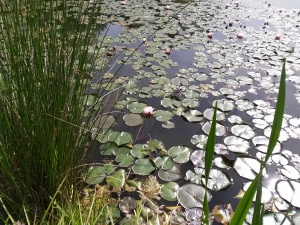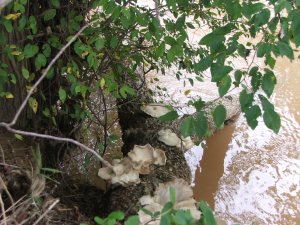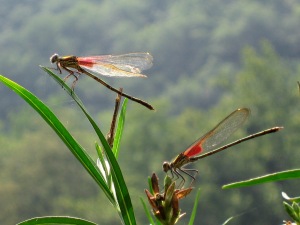This post is based on work done to produce Virginia Water Radio Episode 260 (4/6/15), a 3 min./57 sec. podcast on this topic, available online at http://www.virginiawaterradio.org/2015/04/biodiversity-in-virginia-and-southern.html. Have a listen!
What word could you use to encompass bacteria, beech trees, Blue Crabs, Blue Whales, and millions of other living species on the Earth, from backyards to the whole biosphere?
If you said biodiversity, that’s a good choice! “Biodiversity,” a contraction of “biological diversity,” refers to the any given area’s variety of living species and the ecosystems that support those species. For the earth overall, the number of species is estimated to be in the millions. An area’s biodiversity results from complex interactions among biology, ecology, geology, climate, topography, human activity, and time.
Biodiversity is one aspect of “natural history,” a traditional term for nature study generally, including describing and listing the species found in a given area. The term now encompasses study of an area’s past and present environmental, biological, and human aspects. For example, the American Museum of Natural History in New York City’s Web site (at http://www.amnh.org/about-us) defines the museum’s mission—since 1869—as being “…to discover, interpret, and disseminate information about human cultures, the natural world, and the universe through a wide-ranging program of scientific research, education, and exhibition.” The National Museum of Natural History, part of the Smithsonian Institution in Washington, D.C., states (online at http://www.mnh.si.edu/about.html) that it is “…dedicated to inspiring curiosity, discovery, and learning about the natural world….” And the Virginia Museum of Natural History (in Martinsville) identifies its mission (online at http://www.vmnh.net/about-us) as to “…interpret Virginia’s natural heritage.” Those statements all reflect interests in the many living an non-living factors that affect what kinds of organisms inhabit particular places—that is, a place’s biodiversity.
Scientists consider adequate biodiversity to be crucial for healthy and sustainable natural systems and for those systems’ capacity to provide humans with food, clean air and water, medicines, and many other benefits and services. Those benefits give everyone good reasons to care about biodiversity in general, but, Virginia—like most states—has its own special aspects of biodiversity. The Commonwealth’s variety of physiographic areas—from western mountains and valleys, to rolling hills, to Tidewater estuaries—provides many habitats that support a wide variety of organisms. According to “State of the Union: Ranking America’s Biodiversity,” an April 2002 report by NatureServe, the Commonwealth ranks 12th among states in the number of species, with over 3800. That report also listed Virginia as having the third-highest number of amphibian species, and the 13th highest number of vascular plant species.
Virginia is that the Commonwealth is part of the Southern Appalachian region—stretching from West Virginia and southwestern Virginia to northern Alabama—which is known its high biodiversity, including aquatic organisms. For example, the Upper Tennessee River basin, including the Clinch and Holston river watersheds in Virginia, is known particularly for its diversity of fish and mussels. And the Virginia Department of Game and Inland Fisheries considers the Clinch Mountain Wildlife Management Area—covering about 25,000 acres in Russell, Smyth, Tazewell, and Washington counties—to be Virginia’s “most biologically diverse [management area], due in large part to the vast differences in elevation on the area” (according to the Department’s Web site for the management area, online at http://www.dgif.virginia.gov/wmas/detail.asp?pid=21).
On the other side of the state, biodiversity is an important factor in the overall health of the Chesapeake Bay and Virginia’s other coastal environments, which have great ecological, economic, and historical significance for the Commonwealth.
Below are, first, three photos of Virginia’s biodiversity; second, sources for more information to help you learn more about biodiversity generally, about natural history, and about Virginia’s biodiversity; and, third, information on how this post may help Virginia’s teachers with various science Standards of Learning.
PHOTOS
Three water-related examples of Virginia biodiversity: (top) aquatic plants in a pond in Blacksburg, Va., May 2014; (middle) fungi on a tree limb beside the Bannister River in Pittsylvania County, September 2012; (bottom) damselfly on the New River at Wythe County, July 2012 (photo by Anne Jacobsen, used with permission).
SOURCES FOR MORE INFORMATION
Biodiversity Generally
Elsa E. Cleland, “Biodiversity and Ecosystem Stability,” Nature Education Knowledge Vol. 3, No. 10 (p. 14), 2011, accessed online at http://www.nature.com/scitable/knowledge/library/biodiversity-and-ecosystem-stability-17059965.
John Lloyd, “Biodiversity,” 9/15/14, in “Encyclopedia of Life,” National Council for Science and the Environment, online at http://www.eoearth.org/view/article/150560/.
NatureServe, “State of the Union: Ranking America’s Biodiversity,” April 2002, available online at http://www.natureserve.org/library/stateofunions.pdf.
Biodiversity in the Southern Appalachians
All Taxa Biodiversity Inventory/Discover Life in America, online at http://www.dlia.org/atbi/. This is an effort to document the estimated 100,000 species occurring in Great Smoky Mountain National Park.
Highlands [North Carolina] Biological Station, “Biodiversity of the Southern Appalachians,” online at http://highlandsbiological.org/nature-center/biodiversity-of-the-southern-appalachians/.
Donald W. Linzey, A Natural History Guide to Great Smoky Mountains National Park, University of Tennessee Press, Knoxville, 2008.
U.S. Fish and Wildlife Service Southwestern Virginia Field Office, online at http://www.fws.gov/northeast/virginiafield/svfo/southwesternvirginia.html.
U.S. Geological Survey, “Birth of the Mountains—The Geological Story of the Southern Appalachian Mountains,” by Sandra Clark, online at http://pubs.usgs.gov/gip/birth/.
Natural History
American Museum of Natural History in New York City, http://www.amnh.org/about-us.
National Museum of Natural History, part of the Smithsonian Institution in Washington, D.C., online at http://www.mnh.si.edu/about.html.
Amber Parker, “Natural History and Naturalist Skills,” published by Great Smoky Mountains Institute at Tremont, online (as PDF) at http://www.gsmit.org/downloads/NaturalistSkillsReading2012.pdf.
Virginia Museum of Natural History (in Martinsville), online at http://www.vmnh.net/about-us.
Virginia Biodiversity
Animals Generally
Virginia Department of Game and Inland Fisheries, “Fish and Wildlife Information Service,” online at http://vafwis.org/fwis/?Menu=Home.Species+Information.
Amphibians and Reptiles
A Guide to the Frogs and Toad of Virginia, by John D. Kloepfer and Chris S. Hobson, Special Publication Number 3, Virginia Department of Game and Inland Fisheries/Richmond (2011).
Amphibians and Reptiles of the Carolinas and Virginia, by B.S. Martof et al., University of North Carolina Press/Chapel Hill (1980).
Atlas of Amphibians and Reptiles in Virginia, J.C. Mitchell and K.K. Reay, Virginia Department of Game and Inland Fisheries/Richmond (1999).
Snakes of Virginia, by Donald W. Linzey and Michael Clifford, University of Virginia Press, Charlottesville, 2002.
“Virginia is for Frogs” Web site, Virginia Department of Game and Inland Fisheries, online at http://www.dgif.virginia.gov/wildlife/virginia-is-for-frogs/.
Virginia Herpetological Society, online at www.virginiaherpetologicalsociety.com (herpetology refers to the study of amphibians and reptiles).
Birds
“All About Birds,” Cornell University Lab of Ornithology, online at http://www.allaboutbirds.org; and “Birds of North America Online” Cornell University Lab of Ornithology and American Ornithologists’ Union, online at http://bna.birds.cornell.edu/bna (subscription required for the latter).
E-bird Web site at http://ebird.org/content/ebird/, maintained by the Cornell Lab and the Audubon Society; locations of species observations made by contributors.
Virginia Society of Ornithology, online at http://www.virginiabirds.net.
Fish
“EFish—The Virtual Aquarium,” Virginia Tech Department of Fisheries and Wildlife Sciences, online at http://web1.cnre.vt.edu/efish/ (sections for each fish family).
Freshwater Fishes of Virginia, by Robert E. Jenkins and Noel M. Burkhead (Bethesda, Md.: American Fisheries Society), 1994.
“Selected Freshwater Fish Families,” Virginia Cooperative Extension Publications 420-526, 2009; online at https://pubs.ext.vt.edu/420/420-526/420-526_pdf.pdf.
“Virginia Fishes” [freshwater game species], Virginia Department of Game and Inland Fisheries, online at http://www.dgif.virginia.gov/wildlife/fish/.
“Virginia Saltwater Angler’s Guide/Fish Identification Guide,” Virginia Marine Resources Commission, online at http://www.mrc.virginia.gov/vswft/Angler_Guide/.
Habitats
Virginia Department of Conservation and Recreation/Natural Heritage Program, “Virginia Natural Area Preserves,” http://www.dcr.virginia.gov/natural-heritage/natural-area-preserves/ [accessed 5/16/17].
Virginia Institute of Marine Science (VIMS), Biodiversity promotes multitasking in ecosystems, 4/24/15 news release.
VIMS Marine Biodiversity Lab, online at http://www.vims.edu/research/units/labgroups/marine_biodiversity/.
Insects
Butterflies and Moths of North America Project, Kelly Lotts and Thomas Naberhaus, coordinators, online at http://www.butterfliesandmoths.org/.
Guide to Common Freshwater Invertebrates of North America, by J. Reese Voshell, Jr., McDonald & Woodward Publishing, Blacksburg, Va., 2002.
Iowa State University Department of Entomology, “BugGuide,” online at http://bugguide.net/node/view/15740.
University of Florida Department of Entomology, “Featured Creatures” Web site, http://entnemdept.ufl.edu/creatures/.
Virginia Tech Department of Entomology Insect Identification Lab, online at http://www.insectid.ento.vt.edu/.
Mammals
Mammals of Virginia, by Donald W. Linzey, University of Tennessee Press, Knoxville, 2001.
Mussels
Virginia Department of Game and Inland Fisheries, “Freshwater Mussel Restoration,” online at http://www.dgif.virginia.gov/awcc/freshwater-mussel-restoration/.
Plants
“Flora of Virginia Project” Web site, accompanying the 2012 publication of The Flora of Virginia, the first comprehensive manual of Virginia plants published since the 1700s; online at http://www.floraofvirginia.org/.
Virginia Native Plant Society, online at http://vnps.org/.
“VTree” Web site for the dendrology course by Dr. John Seiler in Virginia Tech’s Department of Forest Resources and Environmental Conservation; offers identification keys and fact sheets to trees and other woody plants throughout North America; online at http://dendro.cnre.vt.edu/dendrology/main.htm.
STANDARDS OF LEARNING INFORMATION FOR VIRGINIA TEACHERS
Information and references on biodiversity may help with the following Virginia 2010 Science Standards of Learning (SOLs):
Grades K-6
4th Grade: 4.5 – plants and animals, including humans, in an ecosystem interact with one another and with non-living components in the ecosystem; plus human influences on ecosystems;
6th Grade: 6.7 – natural processes and human interactions that affect watershed systems.
Life Science
LS.4 – how organisms can be classified;
LS.9 – characteristics of land, marine, and freshwater ecosystems;
LS.10 – ecosystems, communities, populations, and organisms are dynamic and change over time;
LS.11 – relationships between ecosystems dynamics and human activity.
Earth Science
ES.8 – how freshwater resources are influenced by geologic processes and the activities of humans.
Biology
BIO.8 – effects of natural events and human activities on ecosystems and analysis of flora, fauna, and microorganisms of Virginia ecosystems.
Virginia’s SOLs are available from the Virginia Department of Education, online at http://www.doe.virginia.gov/testing/.



Leave a comment